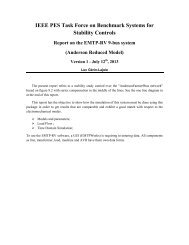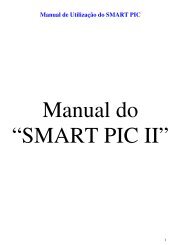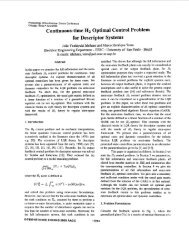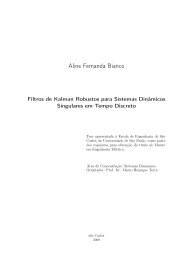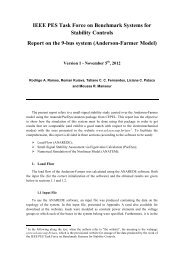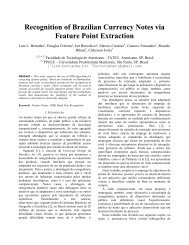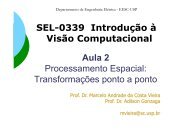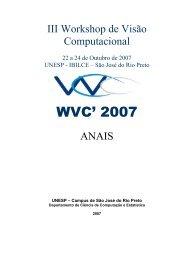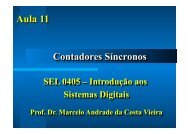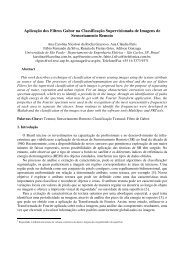A Comparison of Histogram and Template Matching for Face ...
A Comparison of Histogram and Template Matching for Face ...
A Comparison of Histogram and Template Matching for Face ...
Create successful ePaper yourself
Turn your PDF publications into a flip-book with our unique Google optimized e-Paper software.
SPORTSMANSHIPThe Independence School District is a member <strong>of</strong> the Greater Kansas City Suburban Conference<strong>and</strong> Missouri State High School Activities Association (MSHSAA). As members <strong>of</strong> thesegroups, we adhere to policies set down <strong>for</strong> the display <strong>of</strong> good sportsmanship by athletes,students, fans, parents <strong>and</strong> patrons. Member schools are to en<strong>for</strong>ce sportsmanship rules <strong>for</strong> ourown school, players <strong>and</strong> spectators. Violation <strong>of</strong> rules can result in the following consequences:written reprim<strong>and</strong>, probation, suspension, ejection or permanent removal from events.Consequences are in <strong>for</strong>ce <strong>for</strong> players, coaches, students, parents <strong>and</strong> fans.All school discipline policies <strong>and</strong> rules apply to the Independence School District students atschool activities whether they are held on school property or away from school.GOOD SPORTSMANSHIP CODEFor Players, Coaches <strong>and</strong> Fans1. Maintain pride in self <strong>and</strong> school.2. Strive to keep high st<strong>and</strong>ards <strong>of</strong> conduct.3. Cheering is always encouraged <strong>for</strong> one’s own team.4. No taunts, chants, noises, cheers, songs, pr<strong>of</strong>anity, signs or motionsdirected to the opposing team, coach, school or <strong>of</strong>ficials. Treat everyone with respect.5. Positive signs may be displayed <strong>for</strong> one’s own team.6. No disrespect will be shown to the opposing team during introductions.7. No noisemakers.8. No continuous st<strong>and</strong>ing.9. Abide by the decisions <strong>of</strong> <strong>of</strong>ficials.10. Accept victory or defeat graciously.The Independence School District does designate a student spirit section where st<strong>and</strong>ing ispermitted.The Independence School District grounds (inside <strong>and</strong> outside) are, by the Independence SchoolDistrict Board policy, a tobacco-free environment. There is to be no smoking inside the buildingor outside on any school or athletic grounds.4
Rotation Image TM <strong>Histogram</strong>in degrees−20 Figure 5(a) 0.8893 0.9750−10 Figure 5(b) 0.9235 0.9935−5 Figure 5(c) 0.9455 0.99750 Figure 1 1.0000 1.0000+5 Figure 5(d) 0.9506 0.9992+10 Figure 5(e) 0.9243 0.9945+20 Figure 5(f) 0.8847 0.9574Table 5. Similarity values <strong>of</strong> rotated face images.Translation TM <strong>Histogram</strong> Variation inin pixelsSimilarity6 (X) 0.9598 0.9913 3.3%4 (X) 0.9677 0.9963 3.0%2 (X) 0.9760 0.9965 2.1%0 1.0000 1.0000 0.0%2 (Y) 0.9790 0.9992 2.1%4 (Y) 0.9662 0.9966 3.1%6 (Y) 0.9565 0.9879 3.3%Table 6. Similarity values <strong>of</strong> translated faceimages (X <strong>and</strong> Y directions).(a) (b) (c)Figure 6. Sample translated images in X <strong>and</strong>Y directions (shown by dark lines).(d) (e) (f)Figure 5. Sample rotated images.A global assessment <strong>of</strong> all experiments is shown in Table7, where it can be seen that <strong>for</strong> images that involve geometrictrans<strong>for</strong>mations, HM is the best method, <strong>and</strong> it isalso suitable <strong>for</strong> images with Gaussian blur. Since the averagevariation in similarity values between HM <strong>and</strong> TM <strong>for</strong>Gaussian blur is about 1.0%, it can rougly be concluded thatboth methods are suitable <strong>for</strong> this disturbing factor. The previousconclusion regarding HM confirms that histogramsare invariant to rotation <strong>and</strong> translation, as mentioned inSection 3. At the same time, TM produces the best per<strong>for</strong>mancewhen dealing with RGB noise <strong>and</strong> different lightingconditions. As shown in Table 7, the average variation <strong>of</strong>similarity values is most significant <strong>for</strong> changes in lightingconditions when compared to other image variations. Figures7 <strong>and</strong> 8 summarize the brief discussion in this section.These graphs were plotted using the variation in similarityvalues between TM <strong>and</strong> HM <strong>for</strong> each image – the graphin Figure 7 regards images with added noise <strong>and</strong> changes inlighting, <strong>and</strong> the graph in Figure 8 regards images with ge-ometric trans<strong>for</strong>mations. From these graphs, it can be easilyseen that different lighting conditions <strong>and</strong> rotation resultin significant similarity variations between TM <strong>and</strong> HM.Image Best Average VariationVariation Method in SimilarityGaussian blur <strong>Histogram</strong> 1.0%RGB noise TM 6.5%Lighting TM 20.7%Scaling <strong>Histogram</strong> 2.7%Rotation <strong>Histogram</strong> 6.2%Translation <strong>Histogram</strong> 2.4%6. ConclusionTable 7. Per<strong>for</strong>mance comparison.In this work, TM based on cross-correlation <strong>and</strong> histogramswere used to compare face images. In real-worldapplications, images may have variations due to noise, lightingconditions, scaling, rotation <strong>and</strong> translation. To underst<strong>and</strong><strong>and</strong> analyze the influence <strong>of</strong> image variations in theface verification process, TM <strong>and</strong> HM methods were compared.Both methods are dependent on the value <strong>of</strong> im-
color distribution <strong>and</strong> are suitable <strong>for</strong> face recognition <strong>and</strong>related tasks, when dealing with image influenced by disturbingfactors more investigation using local image in<strong>for</strong>mationis needed.ReferencesFigure 7. Variation in similarity values betweenTM <strong>and</strong> histogram <strong>for</strong> Gaussian blur,RGB noise <strong>and</strong> illumination variation.Figure 8. Variation in similarity values betweenTM <strong>and</strong> histogram <strong>for</strong> scaling, rotation<strong>and</strong> translation.age pixels – TM depends on the local pixel in<strong>for</strong>mation,mean HM on the global pixel in<strong>for</strong>mation <strong>of</strong> the face images.According to the comparison <strong>of</strong> methods applied tothe face object image <strong>and</strong> different target face images usedin this work, TM can be considered as a suitable method<strong>for</strong> images with RGB noise, Gaussian blur <strong>and</strong> images withslight variations in lighting conditions, <strong>and</strong> HM <strong>for</strong> face imagesunder different geometric trans<strong>for</strong>mations. As a generalconclusion, it can be pointed out that images withchanges in illumination require more investigation so thatthe most suitable matching method <strong>for</strong> face verificationcan be determined. In this work, global histograms <strong>of</strong> theRGB color channels were analyzed <strong>for</strong> face verification. Althoughglobal histograms capture <strong>and</strong> represent the image[1] J. R. Beveridge, G. H. Givens, P. J. Philips, B. A. Draper, <strong>and</strong>Y. M. Lui. Focus on quality, predicting FRVT 2006 per<strong>for</strong>mance.In Proceedings <strong>of</strong> the 8th IEEE International Conferenceon Automatic <strong>Face</strong> <strong>and</strong> Gesture Recognition, pages1–8, 2008.[2] G. Bradski <strong>and</strong> A. Kaehler. Learning OpenCV. O’Reilly Media,2008.[3] R. Brunelli <strong>and</strong> T. Poggio. <strong>Template</strong> matching: Matched spatialfilters <strong>and</strong> beyond. Pattern Recognition, 30(5):751–768,May 1997.[4] G. D. Finlayson, S. S. Chatterjee, <strong>and</strong> B. V. Funt. Color angularindexing. In Proceedings <strong>of</strong> the 4th European Conferencein Computer Vision, pages 16–27, 1996.[5] R. C. Gonzalez <strong>and</strong> R. E. Woods. Digital Image Processing.Prentice Hall, 3rd edition, 2009.[6] H. Guo, Y. Yu, <strong>and</strong> Q. Jia. <strong>Face</strong> detection with abstracttemplate. In Proceedings <strong>of</strong> the 3rd International Congresson Image <strong>and</strong> Signal Processing, volume 1, pages 129–134,2010.[7] W. Jia, H. Zhang, X. He, <strong>and</strong> Q. Wu. A comparison on histogrambased image matching methods. In Proceedings <strong>of</strong>the 3rd IEEE International Conference on Video <strong>and</strong> SignalBased Surveillance, pages 97–102, 2006.[8] Z. Jin, Z. Lou, J. Yang, <strong>and</strong> Q. Sun. <strong>Face</strong> detection usingtemplate matching <strong>and</strong> skin-color in<strong>for</strong>mation. Neurocomputing,70(4-6):794–800, January 2007.[9] Z. Liu <strong>and</strong> C. Liu. A hybrid color <strong>and</strong> frequency featuresmethod <strong>for</strong> face recognition. IEEE Transactions on ImageProcessing, 17(10):1975–1980, October 2008.[10] B. S. Manjunath, J.-R. Ohm, V. V. Vasudevan, <strong>and</strong> A. Yamada.Color <strong>and</strong> texture descriptors. IEEE Transactions onCircuits <strong>and</strong> Systems <strong>for</strong> Video Technology, 11(6):703–715,June 2001.[11] S. E. Palmer. Vision Science: Photons to Phenomenology.MIT Press, 1999.[12] G. Pass <strong>and</strong> R. Zabih. Comparing images using joint histograms.Multimedia Systems, 7(3):234–240, 1999.[13] A. K. Sao <strong>and</strong> B. Yegnanarayana. <strong>Face</strong> verification usingtemplate matching. IEEE Transactions on In<strong>for</strong>mationForensics <strong>and</strong> Security, 2(3):636–641, September 2007.[14] X. Tan, S. Chen, Z.-H. Zhou, <strong>and</strong> F. Zhang. <strong>Face</strong> recognitionfrom a single image per person: A survey. Pattern Recognition,39(9):1725–1745, September 2006.[15] M.-H. Yang, D. J. Kriegman, <strong>and</strong> N. Ahuja. Detecting facesin images: A survey. IEEE Transactions on Pattern Recognition<strong>and</strong> Machine Intelligence, 21(1):34–58, January 2002.[16] H. Zhou <strong>and</strong> G. Schaefer. Semantic features <strong>for</strong> face recognition.In Proceedings <strong>of</strong> the 52nd International SymposiumELMAR-2010, pages 33–36, 2010.




